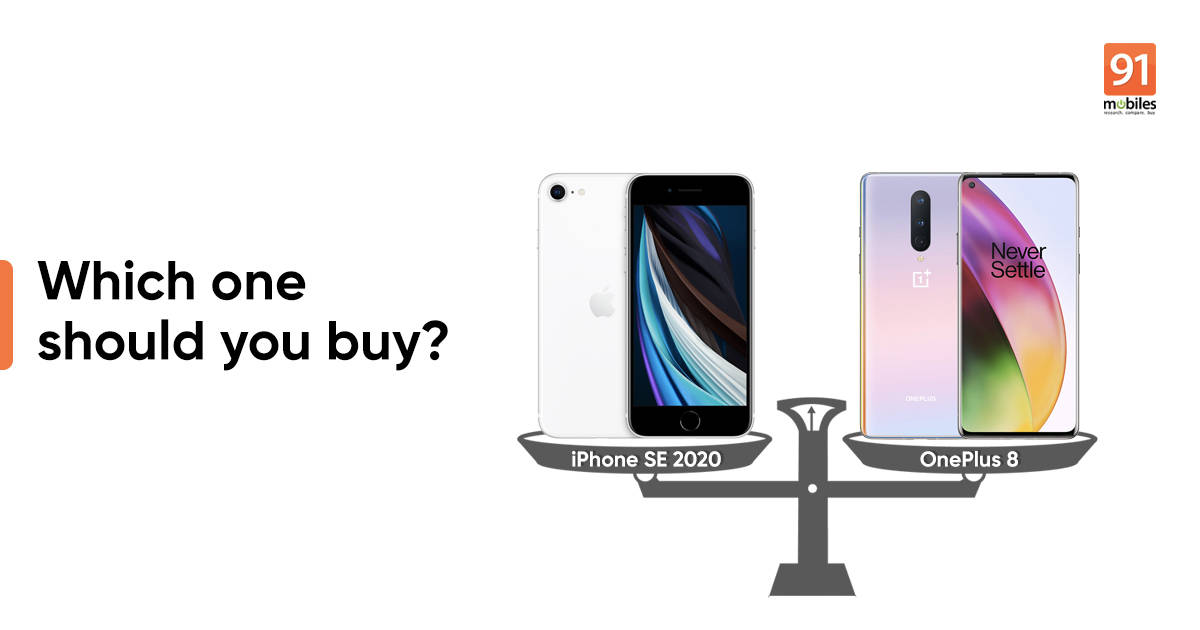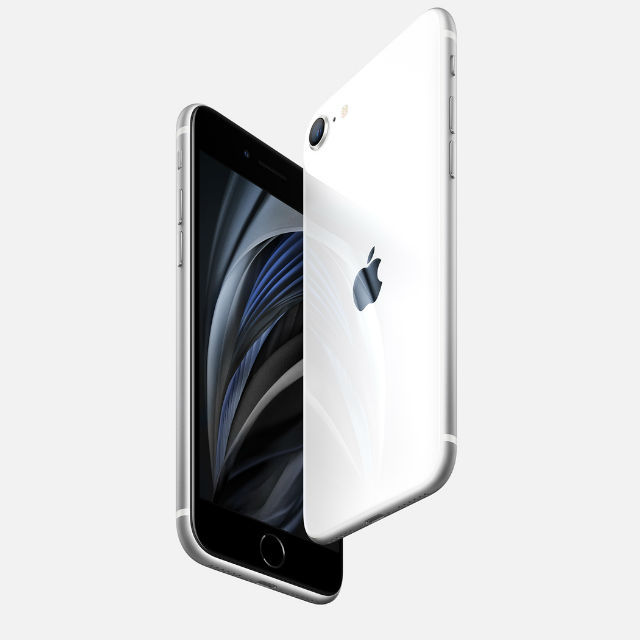
OnePlus 8 is finally going on sale in India today, though this will be a limited period sale that will see only a few units up for grabs. The smartphone competes with a lot of Android devices, from Realme X50 Pro to Xiaomi Mi 10, but its primary competition in the country is with iPhone SE 2020. Both smartphones come from, arguably, the most popular brands today and are priced roughly the same. The OnePlus 8 price in India starts at Rs 41,999, whereas the iPhone SE 2020 costs Rs 42,500 for the base 64GB storage variant. However, despite being priced identically, the two smartphones cater to different audiences as they belong to different ecosystems. Are you confused about whether you should buy OnePlus 8 or iPhone SE 2020? Read on to find out.
OnePlus 8 vs iPhone SE 2020 price in India
The iPhone SE 2020 comfortably beats OnePlus 8 in pricing in the global market, but that’s not the case in India. The OnePlus 8 is cheaper than the iPhone in the country. The OnePlus 8 price in India is set at Rs 41,999 for the base model with 6GB RAM and 128GB internal storage. The 8GB + 128GB version is priced at Rs 44,999 while the 12GB RAM and 256GB option costs Rs 49,999. The handset comes in Interstellar Glow, Glacial Green, and Onyx Black hues and will be on a limited-period sale later today at 12pm on Amazon.in. Customers purchasing the smartphone via SBI credit cards will get Rs 2,000 discount, while payments made using Amazon Pay will get the buyer Rs 1,000 cashback.
The iPhone SE 2020 has been priced at Rs 42,500 for the 64GB storage variant. The phone also comes in 128GB and 256GB options, which have been priced at Rs 47,800 and Rs 58,300 respectively. The iPhone comes in Black, White, and Red colours and is already on sale in India. Buyers can get Rs 3,600 discount on HDFC Bank credit card (single swipe as well as EMI) and debit card (single swipe transactions); HDFC Bank debit card EMIs will get Rs 1,000 discount.
| Model | Variant | Price | Offer |
| OnePlus 8 | 6GB + 128GB | Rs 41,999 | Rs 2,000 discount on SBI credit cards, Rs 1,000 discount via Amazon Pay |
| 8GB + 128GB | Rs 44,999 | ||
| 12GB + 256GB | Rs 49,999 | ||
| iPhone SE 2020 | 64GB | Rs 42,500 | Up to Rs 3,600 discount on HDFC Bank credit and debit cards |
| 128GB | Rs 47,800 | ||
| 256GB | Rs 58,300 |
Who should buy iPhone SE 2020
iPhone SE 2020 is probably the most compact mid-range smartphone in the market right now. Therefore, it will be the obvious choice for anyone who wants a smartphone without an unwieldy size but does not compromise much on performance. So, if you’re not into the new-age tall display and swanky 19:9/ 20:9 aspect ratio phones, believe me, you’ll be very content with the size of iPhone SE 2020. The handset measures just 138.4×67.3×7.3mm – even with those huge bezels – and ships with a 4.7-inch Retina HD display for seamless one-handed usage.
The new iPhone SE 2020 will also be a great choice for people looking to enter the iOS ecosystem and are looking for an iPhone that doesn’t cost a bomb. It is far cheaper than the other new iPhone models out there but offers the same processor and software (+ software support) as them.

For those unaware, the handset packs Apple’s latest A13 Bionic chipset under the hood. It’s a high-end power-efficient chipset that means you’ll not face any problem with the performance of the device whatsoever. The chipset is mated with 3GB of RAM, which is enough for an iPhone of this calibre, and up to 256GB storage. The handset comes with iOS 13 running out of the box, which is great if you’re heavily tied up to Apple ecosystem. For others, the experience will not be that great, but you’ll still get all the features of an iOS such as privacy, software updates for the next four years, and more.
However, there are some compromises to be made with the iPhone SE 2020. The iPhone SE 2020 comes with the same battery life as the iPhone 8. The handset is rated to last up to up to a day on moderate to heavy usage and support 18W fast charging (though a paltry 5W charger is shipped in the box) and wireless charging support. For photography, the iPhone SE 2020 features a not so modernised setup. The rear camera is a single 12MP shooter with f/1.8 aperture, dual-pixel PDAF, OIS, and dual-tone, dual-LED flash, while the front camera gets a 7MP selfie camera with f/2.2 aperture, portrait mode, and on-screen flash. The cameras come with all the Apple goodness like 4K video, time-lapse, and slow-mo recording capabilities, but we are yet to see its performance in real-life.
Other features include a Lightning port for charging, IP67 water- and dust-resistance certified, Touch ID fingerprint sensor (no Face ID), and Haptic Touch for Quick Actions as well as contextual menus. The design is also quite old and had not been seen in an Apple smartphone since 2017.
Who should buy OnePlus 8
OnePlus 8, on the other hand, doesn’t offer the same size benefit as iPhone SE 2020. In fact, The handset is anything but compact. Secondly, it is ideal for those who are sticking to the Android ecosystem and do not want a new OS experience altogether. Moreover, if someone is moving from iOS to Android, OnePlus 8 will be a great choice since Oxygen OS offers one of the best UI experiences we have seen on Android.

Moving on to the specs, OnePlus sports a large 6.55-inch display of Fluid AMOLED variety, bearing Full-HD+ resolution, in-display fingerprint scanner, and 90Hz refresh rate. The display sports minimal bezels, 20:9 aspect ratio, and a cut-out in the top left corner for the selfie camera. It’s a better display than iPhone SE 2020, but try using it with one hand! Nonetheless, it is great to watch videos and play games.
OnePlus 8 is powered by Snapdragon 865 SoC, which is the flagship chipset from Qualcomm. The SoC is 25 percent faster than its predecessor Snapdragon 855+, and initial benchmarking results have shown that it’s no slouch in comparison to A13 Bionic chipset. The performance is further optimised by OxygenOS that runs atop Android 10. The custom Android skin from OnePlus is considered the best in the industry. It comes with a near stock-Android experience with a bevvy of features and no irritating ads. The OnePlus 8 also comes with 5G connectivity, which is still a distant dream in India but if you want to be future-ready you can invest in the device.
A 4,300mAh battery fuels the OnePlus 8. While it’s not backed by wireless charging support, the handset supports Warp Charge 30T fast charging tech. OnePlus claims that the tech can charge the device from 0 to 50 percent in less than 30 minutes. What’s more? The charger comes bundled with the OnePlus 8.
As for the cameras, the OnePlus 8 has as many as three at the back – giving more versatility to its users than iPhone SE 2020. The handset packs a 48MP Sony IMX586 primary sensor with OIS, EIS, and f/1.75 lens, a 2MP macro sensor with f/2.4 lens, and a 16MP ultra-wide sensor with f/2.2 lens and 116-degree field-of-view. They are backed by a slew of modes, such as HDR, Nightscape, Super Macro, Portrait Pro, AI Scene Detection, and up to 4K video recording. On the selfies part, there is a 16-megapixel Sony IMX471 sensor at the front along with an f/2.45 lens.
from 91mobiles.com https://bit.ly/3gygprV
via gqrds
No comments:
Post a Comment